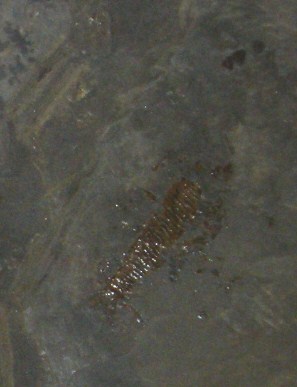
Atopocephala is an extinct genus of prehistoric freshwater ray-finned fish that lived during the Middle Triassic epoch. It contains a single species, A. watsoni from the Karoo Supergroup of South Africa. A potential indeterminate species was known from the Timezgadiouine Formation of Morocco, but is now considered an indeterminate actinopterygian.
Tungusichthys is an extinct genus of prehistoric bony fish that lived during the Early Triassic epoch.

Watsonulus is an extinct genus of prehistoric ray-finned fish that lived during the Early Triassic epoch in what is now Madagascar. It may have also existed in what is now Himachal Pradesh, India, during the Induan age. The type species, described by Jean Piveteau, is Watsonia eugnathoides. Because "Watsonia" was preoccupied, the new genus name Watsonulus was later erected. The genus is named after David Meredith Seares Watson.
Tripelta is an extinct genus of prehistoric bony fish that lived during the Anisian age in what is now New South Wales, Australia.
Daedalichthys is an extinct genus of prehistoric freshwater ray-finned fish that lived during the Early Triassic epoch. It contains a single species, D. formosa from the Olenekian-aged Cynognathus Assemblage Zone of South Africa. It was previously classified in Dictyopyge.

Brookvalia is an extinct genus of prehistoric freshwater ray-finned fish that lived during the Middle Triassic epoch.

Dictyopyge is an extinct genus of prehistoric freshwater ray-finned fish that inhabited eastern North America during the early part of the Late Triassic. Two species are recognized, both from the early Carnian-aged Doswell Formation in what is now Virginia, United States:
Agecephalichthys is an extinct genus of prehistoric freshwater "palaeonisciform" ray-finned fish that lived during the Anisian age. It contains a single species, A. granulatus from the Hawkesbury Sandstone in what is now New South Wales, Australia.
Gigantopterus is an extinct genus of prehistoric bony fish that lived during the Carnian stage of the Late Triassic epoch.
Elpistoichthys is an extinct genus of prehistoric bony fish that lived during the Carnian stage of the Late Triassic epoch.
Dorsolepis is an extinct genus of prehistoric bony fish that lived during the early Anisian age in what is now France (Alsace) and Germany (Baden-Württemberg). Fossils were found in the Grès à Voltzia in Alsace and in the Buntsandstein in Baden-Württemberg.

Garnbergia is an extinct genus of prehistoric coelacanth that lived during the Anisian stage of the Middle Triassic epoch. It was discovered by Martin and Wenz in 1984. It comprises a single species, Garnbergia ommata.
Chrotichthys is an extinct genus of prehistoric freshwater ray-finned fish that lived in the Anisian stage of the Middle Triassic epoch. It contains a single species, C. gregarius, known from the Terrigal Formation of New South Wales, Australia.

Paracentrophorus is an extinct genus of prehistoric ray-finned fish that lived during the Induan age of the Early Triassic epoch in what is now Madagascar. The type species is Paracentrophorus madagascariensis (monotypy).
Luganoia is an extinct genus of prehistoric bony fish that lived during the Anisian and Ladinian ages of the Middle Triassic epoch. Fossils were recovered from the Besano Formation of Monte San Giorgio and Besano area and from the Zhuganpo Member of Guizhou, South China. It was also reported from the Ladinian of Spain.

Habroichthys is an extinct genus of prehistoric bony fish that lived during the early Ladinian stage of the Middle Triassic epoch, 242 to 232 million years ago. It has been found in Austria, China, Italy, Slovenia, and Switzerland. It was a small fish measuring 26 cm (10 in) long.
Alleiolepis is an extinct genus of prehistoric bony fish, which lived during the Ladinian age of the Middle Triassic epoch in what is now Franconia, Germany. It is generally considered a semionotiform. It was first named Leiolepis, but because this genus name is preoccupied by an extant lizard, the genus name of the Triassic fish was changed to Aleiolepis.
Eigilia is an extinct genus of prehistoric bony fish that lived during the Roadian age in what is now Kazakhstan.
Korutichthys is an extinct genus of prehistoric marine bony fish that lived during the Lopingian epoch in what is now Krasnoyarsk Krai, Russia. It was first referred to the family Amblypteridae, a view that was later questioned.

Saurorhynchus is an extinct genus of carnivorous bony fish that lived during the Early and Middle Jurassic epochs. Fossils have been found in Europe and North America (Canada). It is commonly found in pelagic and lagoonal deposits, but mostly marine. Largest specimens can grow up to 1.9 metres (6.2 ft).







